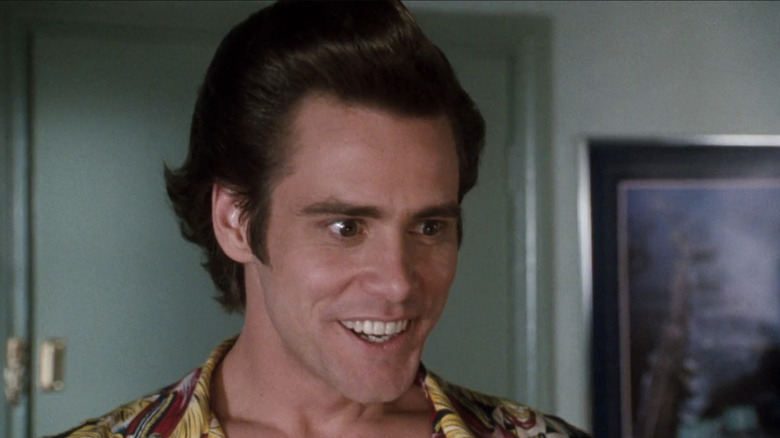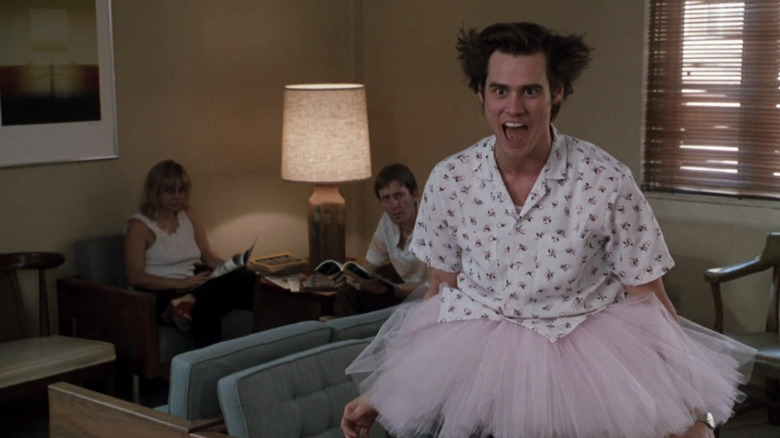Not Everyone Working On Ace Ventura Thought Jim Carrey Could Pull It Off
Jim Carrey began his entertainment career in the '70s as a stand-up comedian, where he entertained audiences with physical comedy and spot-on impressions of celebrities like Sammy Davis, Jr., and Clint Eastwood. In the 1980s, he landed smaller roles in TV and movies before becoming a regular on the comedy sketch show "In Living Color" in 1990. Carrey quickly proved to be a valuable asset to the show by lampooning pop culture figures like Vanilla Ice and creating a wacky list of recurring characters such as Fire Marshall Bill and Vera De Milo. Despite being part of an ensemble cast that included other heavyweight talents like David Alan Grier, Jamie Foxx, and Keenan and Damon Wayans, Carrey's comedic abilities stood out. "In Living Color" ended in 1994, but Carrey's career was only beginning.
Immediately after "In Living Color," Carrey was tapped to play the lead in a bombastic comedy named "Ace Ventura: Pet Detective." The movie focused on Ace, an eccentric, at times obnoxious private detective with an affinity for hair gel and exotic animals. During production, Carrey leaned into his unique brand of exaggerated comedy and fully embraced ridiculousness, which some thought would make the movie a total disaster.
'Aaall righty, then.'
Although Carrey had done stand-up around Canada, appeared in small films like "Once Bitten," and been a popular cast member on "In Living Color," he was far from a household name, but it wouldn't take long for that to change.
When Carrey accepted the role of Ace Ventura, he knew it was a huge opportunity to transition from television to film, but he didn't let the pressure change his style. During his time on "In Living Color," Carrey had already found his shtick, which included a blend of physical comedy, memorable one-liners and a bit of foolishness, and he decided to further embrace his quirkiness in the film world. "I wanted to be unstoppably ridiculous," Carrey told The LA Times back in 1994, "and they let me go wild."
By now, everyone knows that a Jim Carrey comedy will include foolishness that dances up to and occasionally dips a toe over the line into obnoxious, but film crews didn't know how to react to it back in '94. Cinematographer Julio Macat thought Carrey was funny, but he was thrown off by the comedian's portrayal of Ace. "The stuff he was doing was so over the top," Macat told The Ringer in 2019, "I truly thought [it] was gonna be the biggest piece of sh*t ever."
You can't blame Macat for having his doubts because even Carrey wasn't sure his exaggerated performance would succeed. "I knew this movie was going to either be something that people really went for, or it was going to ruin me completely," he confessed to The LA Times. Luckily for Carrey, the gamble paid off with audiences, and "Ace Ventura: Pet Detective" grossed a staggering $107 million. That's seven times the original budget of $15 million.
Critical 'lah-hoo-zuh-her'
Carrey's in-your-face tactics were a hit with moviegoers, but critics were not impressed by a character who makes weird faces and talks through his backside. Roger Ebert gave the movie one star and declared it to be "a long, unfunny slog through an impenetrable plot." Empire's review got more personal and called Carrey "a poor man's Jerry Lewis."
Despite all the negative critical opinions, Carrey's performance in "Ace Ventura: Pet Detective" turned him from a popular TV actor into a superstar. For a while, everyone and their mother was quoting the pet detective, especially the catchphrase, "All-righty, then!" The line seemed to hang around forever, and if I'm honest, I still hear it in Carrey's voice whenever anyone uses it in casual conversation.
Carrey quickly followed up the success of Ace with another zany character, Stanley Ipkiss. Also released in 1994, "The Mask" was an even bigger hit than "Ace Ventura: Pet Detective" and grossed a ridiculous $351 million dollars. And, this time, critics enjoyed Carrey's antics. Ebert called the movie the "perfect vehicle for the talents of Jim Carrey," and Empire thought the film was "tailored for Jim Carrey."
The actor concluded 1994 with "Dumb & Dumber," which Time admitted was lowbrow, but "laugh out loud" funny. The film convinced Ebert that Carrey was "a true original," even though he only gave the film 2 stars.
It's hard to wrap my head around the massive differences in critical opinions surrounding the three movies. Pulling back, looking at them as a whole, they aren't that different.
Carrey's unique appeal
Carrey is often compared to the iconic comedian Jerry Lewis, and that's probably the closest possible comparison, but truthfully, the comedian is one of a kind. Lewis' performances were often weird, nerdy, and certainly absurd, but Carrey took that torch and ran with it. Before 1994, no one had ever seen a comedian be as wacky and ridiculous as Carrey was in '94, and the fact that it worked took a lot of people by surprise, especially critics.
Whether he's playing a weirdo P.I., a lovesick simpleton, or a green-faced victim of possession, Carrey always delivers the same exuberance and lunacy. But why did critics react so differently to three films that all offer the same style of comedy? Maybe, like the "Ace Ventura: Pet Detective" cinematographer, they were witnessing something totally new and original, and they weren't sure how to react. Some of their criticisms are fair. Yes, "Ace Ventura: Pet Detective" and "The Mask" are ridiculous movies, and yes, "Dumb and Dumber" is, well, dumb, but Carrey's quirky talents and dedication to silliness turned three flop-worthy films into massive successes.



